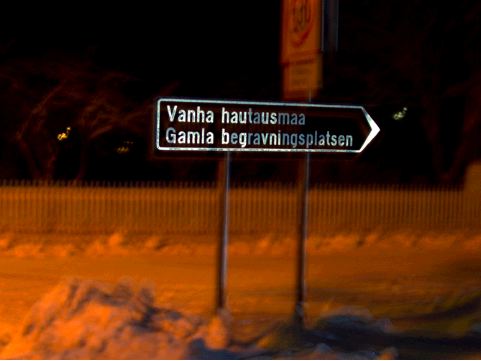

In the photograph above is pointed the way to an old burial ground. What does "Vanha hautausmaa" mean? And how is it possible that the ground is blazing that way in winter? What’s your idea about this picture series, and why does it belong to the Re-Institutionalize project?
On the sign is written in Finnish and Swedish: The Old Cemetery. The writing is made in high reflexive colours, maybe this confused the adjustment of my digital camera. The photos have very strange and varying colour shades already in the original version, but I pronounced the colour differences a bit more to create certain moods. I got the idea for this documentation on a night walk on 25 December, 2004 in Lovisa in Finland. I wanted to regard my walk at the cemetery as an exhibition. The former Re-Institutionalize projects have also been closely related to gestures, yet gestures with a concrete artistic reference each time: to place an object somewhere, for example. This time, the gesture is to experience and to look at a specific site.
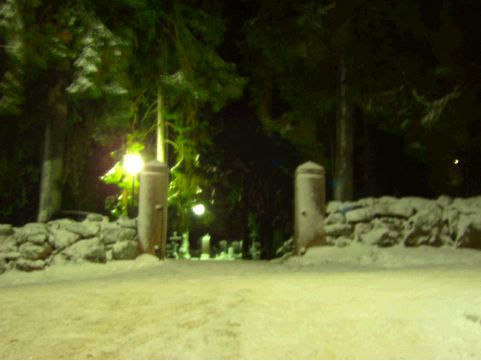
Do you show, with these images of a cemetery at night in winter, anything of that artificial calmness Baudelaire described as his ironic attitude, or is it a melancholic collection of pictures? The cold light of the lanterns, the lights on the snow-covered graves, heaps as of burning coals - lights trying to substitute in vain the light of the moon, the sun and fire, those are illustrative symbols. But maybe something different is important. I understood only on closer inspection that the photographs are in a progression, not just pictures of the place and a subject. Can you say what you describe, and which feelings or thoughts participated in the creation?
My intention was not just to make a picture series of a cemetery. I wanted to communicate my experience – the emotional and the mental disposition during my walk. I was on a night walk on 25 December because I felt very sad and wanted to compose my thoughts outside in fresh air. Then, somehow, I ended up there, and that place seemed to me wonderfully extraterrestrial... Baudelaire’s "spleen" hit me really strong, and suddenly I reached quite another mental disposition. This experience was very strong, like visiting a beautiful exhibition. And then I thought that I should try to retain this experience as an exhibition and pass it on to others. I went home quickly, took my camera with me and returned in order to reconstruct my experience through photographs. So it was not a live report but a reconstruction or sort of a "re-enactment" in pictures.
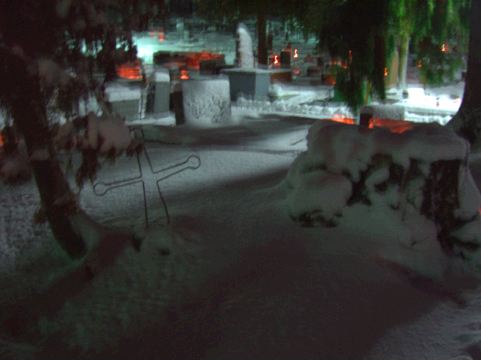
Is there a mission in contemporary art that you want to fulfil, or are you interested in outlining a distance from certain phenomena? Is it necessary for the viewer to give up his/her associations and to understand the whole thing as a provocation, as a look out of another world in which time is withdrawn – a world that is as real as the circles of hell Dante passed in his "Divine Comedy"?
For me there is something like a mission of art. I come from a family with several priests. One of them, Kurt Paetau, was even a poet and a priest. And I think that preaching is a very interesting form of communication... I myself am not religious at all, but I appreciate the art that is able to take over some kind of religiousness. On 25 December, a lot of people visit the cemetery, many of them just this once in the year. When I was there, I didn’t see any people there any more, but the candles were still burning. The feeling of timelessness was very strong. The snow also participated in the forming of a sleeping dream landscape.
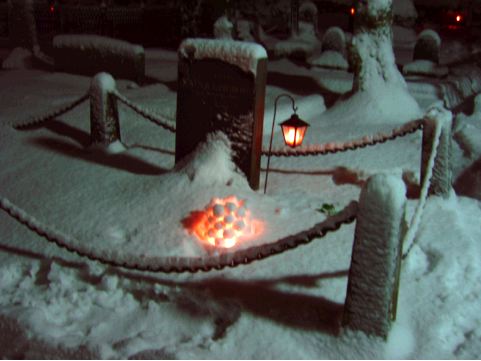
Maybe the photographs present a single opposite: the human loneliness; or its mirroring or mask or parable. More or less like Arcimboldo, in the 16th century, painted allegories of summer or winter: portraits composed of the adequate living beings in a certain rich totality (presenting thereby his artistic imagination, too). Or, vice versa: In Arcimboldo’s work the transient, the returning, life - here: the past, the unknown, death.
I regard allegories as very important and hope that I will work with allegories more in the future. But one has to develop - constantly - new appearances of allegories. In this case, I didn’t intend to make an allegorical work, and I am not so sure whether the project is actually presenting an allegory. But it has allegorical tendencies... If it is able to express my "spleen" of that evening in the year 2004, I am satisfied for the moment. Yet one shouldn’t forget the other components of this work: that it is a reconstruction; and that the work appears as a documentation, together with this text. And that the cemetery here mutates into an art institution, into a place of artistic encounter.
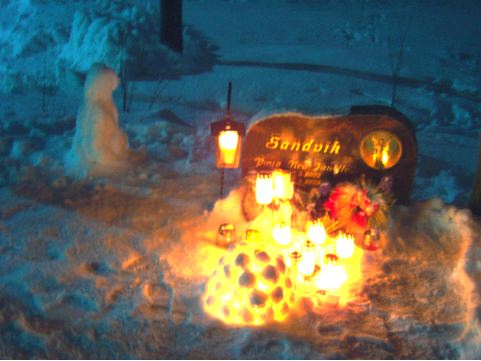
Is it difficult to choose the human being in his/her appearances and their pictures, copies and fakes – or, as you do it here: in his/her non-appearances – for subject, isn’t it a very fundamental, wide, very great demanding?
Perhaps, but this is the subject I am interested in. And it is a very wide subject – fortunately! But the demand isn’t given with the subject, it depends on where you set it up, and with which demand you approach some given subject. My greatest demand is, presumably, to think that the work I make is interesting for someone, and that, therefore, I want to turn to as many people as possible.
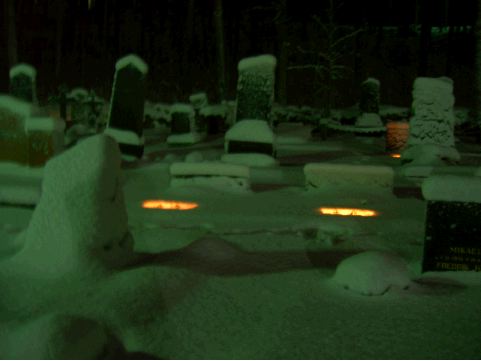
Do you think it is necessary to react on phenomena as the globalization and the Internet, political and technical changes? Are these phenomena so meaningful? How do they change the aesthetic concepts of individuals and of groups and institutions? Or should I ask whether they change the image that one has of him/herself?
For me, it seems to be meaningful to work that way. But I do not believe that I react directly to the phenomena you’ve mentioned – although these phenomena act on me each day, for years. At some point they became an integral part of my life, and they continue to influence the way I think, communicate and make art. So they might well change our view on aesthetics as well as our understanding of groups and institutions. This means that we have to adapt ourselves to our view on the world again and again – and that changes our self-image, too. However, I wouldn’t exaggerate the importance of phenomena like the globalization and the Internet. In the end, we are standing in front of the mirror each morning, wondering who’s looking at us there and what on earth we should undertake with him/her.
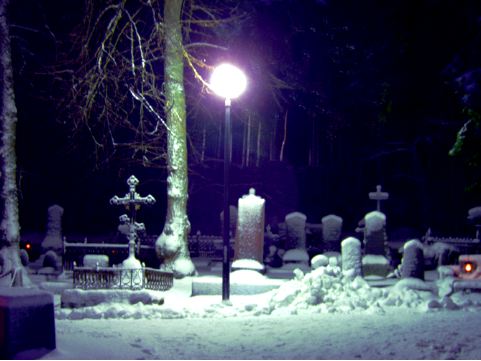
The first photograph, pointing the way, reminds me of William Turner’s "Fighting Temeraire". There is the well known legend about Turner – and of another artist as well – that he spent time in a snow storm in order to study the power of nature as a more profound impression than the human sphere. Do you see yourself in such a tradition?
Turner’s painting "The Fighting Téméraire Tugged to Her Last Berth to Be Broken Up"* is a very beautiful and important – political – allegory! But actually I can’t see myself in the tradition you’ve mentioned – although I remember very well how my fingers were getting frozen while I was making those photographs at the cemetery…
* http://www.svcc.cc.il.us/academics/classes/murray/hum210/terrimt.htm
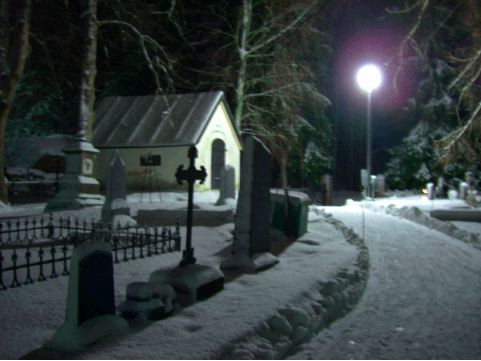
Interview: Heike Wetzig & Kristofer Paetau, February 2005
Re-Institutionalize # 06: The Old Cemetery